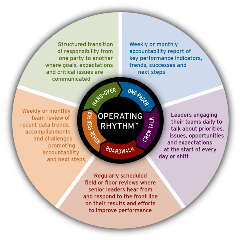By Han Juch and Jerry Weisenfelder
At RLG International, we have nearly 35 years of experience in supporting organizations around the world in becoming high performing. We know what it takes to get a step change in result. Executives turn to us when their teams need a boost in dealing effectively with market and business environment challenges, to counter organisation complacency, complexity and silo-ing. We partner with them to produce:
- clarity of strategic, execution and operation goals,
- attention to key result dimensions of safety, production, cost and business improvement,
- active use of systems, metrics, processes and tools,
- clear leadership,
- consistent focus on results versus activity, actions, teamwork across functions, and workforce engagement.
Our key offer to generate the step change in results lays in the application of proven Performance Improvement tools, Leadership Development at all levels, and the establishment of an Operating Rhythm™.
If there is one element that in our experience creates and sustains a change in behaviour while generating high safety, performance and cost results, it would be Operating Rhythm.
Operating Rhythm™ is the set of recurring interactions between key people of various functions, levels and locations who are required to advance the operating performance of their part of the business.
Start by thinking of meetings and structured interactions as a rhythm, like an organizational drumbeat, with beats and intervals matching the corresponding performance time horizons and action cycles. Regularly, per shift, daily, weekly, monthly, quarterly and so on. The rhythm occurs in the flow of the conversation with focus on:
- the current reality,
- the end in mind,
- the foreseen action possibility,
- the commitment to actions, and
- the close out of actions with recognitions and learning.
This happens interactively, with participation by all, across levels and functions.
We like to say, it “connects the front line to the bottom line,”
creating
one
team from many, with a focus on business performance and
with an upbeat tone in contrast to the static and boring traditional interactions.
The main difference with the typical meeting cadences lay in the quality of the conversations due to strengthened behaviours of leaders and participants. With Operating Rhythm™ conversations, instead of the usual storytelling, we aim for generative conversations* in which clear commitments for action are made, followed up and closed out. All participants share accountability for the results with personal responsibility for taking initiative, and for making and keeping their promise. Their required mindset is of personal accountability, teamwork, and embracing continuous improvement. Leaders ensure a mutual understanding of the current business reality, to be clear on intent and focus, while giving space for and coaching participants to take up their personal accountabilities and clear agreements on how to go forward. The language and metrics used during the interactions are specific, clean and empowering.
In our view it is not ‘what gets measured gets done’, but what is understood, shared, agreed and focused-on is what gets done.
High performing organisations are created not by individuals, but by an across-the-board sharing of know-how and seen possibilities. They have clear alignment of key actions that lead to the desired results. A great Operating Rhythm™ will breathe life and energy into an organization, driving and sustaining performance at an elevated level. It will lift the organisational spirit and level-up the sense of engagement throughout the organisation. An Operating Rhythm™ connects the technical people with the business priorities, the Front Line with the Bottom Line, and the Top Line with the Front-Line realities, ideas and motivation.
While Operating Rhythm™ sets up an organisation for high performance, and even for a culture change, by now it will be clear that setting up Operating Rhythm is not straight forward. A good Operating Rhythm™ is not simply about setting up a frequency of meetings with the usual metrics and action list. Indeed, most organisations can do that by themselves without much help. Rather, an effective Operating Rhythm requires a change of behaviour, conversation, language and mindset of both leaders and participants.
In simple terms, look at Operating Rhythm™ like acts in a play; the metrics and performance boards are the stage with all the structural elements such as lighting, backdrop, and props. The timing, sequence and cascading of the meetings are the acts that should occur in a clear order that helps tell the story. Finally, the leaders and participants are the actors who each have a critical part to play and lines to recite. It is this final element that can sometimes be the most challenging to do right and where there is the most leverage.
The quality of an organization’s Operating Rhythm is one of its best leading indicators of success and should be a top priority of every leader. Indeed, behind every great Operating Rhythm™ are motivated and strong leaders along with a fully engaged organization. This will not only have a direct impact on the ability of an organization to achieve results, it will also have a direct impact on the capability of that organization’s individuals.
* Generative Conversation is dialog focused on learning, engagement, accountability and commitment. It contrasts with typical organizational dialogs which are transactional, emotional and based upon telling. Generative conversations are about listening, sharing ideas, perspectives and questions to produce mutual understanding and common sense of direction. With our coaching approach to implementation, we introduce Generative Conversation into organizations as a foundation of our Leadership Capability Development programme, called Leading Well™.